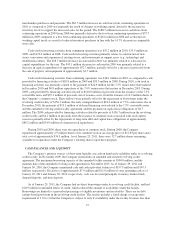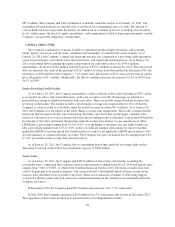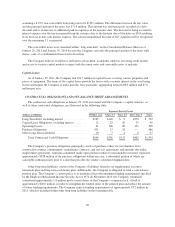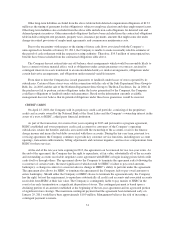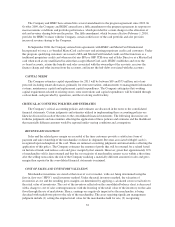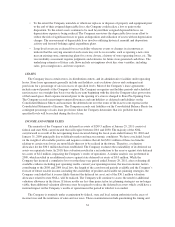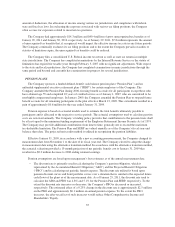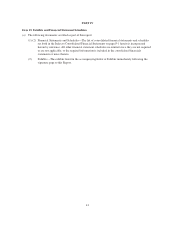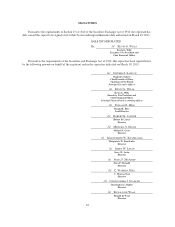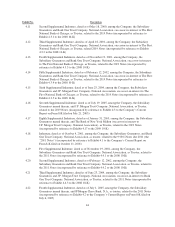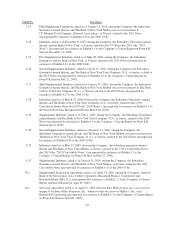Saks Fifth Avenue 2010 Annual Report Download - page 37
Download and view the complete annual report
Please find page 37 of the 2010 Saks Fifth Avenue annual report below. You can navigate through the pages in the report by either clicking on the pages listed below, or by using the keyword search tool below to find specific information within the annual report.• The expected long-term rate of return on plan assets is used primarily in calculating the expected return
on plan assets component of the Company’s net periodic benefit expense. The Company’s estimate of
the expected long-term rate of return considers the historical returns on plan assets, as well as the future
expectations of returns on classes of assets within the target asset allocation of the plan asset portfolio.
The assumed expected long-term rate of return on plan assets is the weighted average rate of earnings
expected on the funds invested or to be invested to provide for the benefits included in the PBO. The
Company’s investment strategy is to maintain a diversified portfolio of asset classes with the primary
goal of ensuring that funds are available to meet the Pension Plan’s benefit obligations when they
become due, while maintaining an appropriate level of risk. The Pension Plan’s target asset allocation
is determined by the Company’s Retirement Committee and for the year ended January 29, 2011, the
Pension Plan’s target asset allocation was approximately 55% equity, 40% fixed income, and 5% real
estate. To the extent the actual rate of return on assets realized is greater than or less than the assumed
rate of return, that year’s annual pension expense is not affected. Rather, the gain or loss is recognized
in Accumulated Other Comprehensive Income and would reduce or increase future pension expense
over a period of approximately 10 years. The Company’s expected long-term rate of return on plan
assets was 8.0% in 2010. The estimated effect of a 0.50% change in the long-term rate of return on plan
assets is $0.6 million on the net periodic benefit expense.
• The assumed average rate of compensation increase is the average annual compensation increase
expected over the remaining employment periods for the participating employees and is primarily used
in calculating the PBO and net periodic benefit expense. No assumption was used in 2010 as the
Pension Plan was amended to suspend all future benefit accruals for all active participants.
RECENTLY ISSUED ACCOUNTING PRONOUNCEMENTS
In January 2010, the Financial Accounting Standards Board (“FASB”) issued an accounting standard update
related to improving disclosures about fair value measurements. The update requires reporting entities to make
new disclosures about recurring or nonrecurring fair value measurements including significant transfers into and
out of Level 1 and Level 2 fair value measurements and information on purchases, sales, issuances, and
settlements on a gross basis in the reconciliation of Level 3 fair value measurements. The accounting standard
update is effective for reporting periods beginning after December 15, 2009, except for Level 3 reconciliation
disclosures which are effective for periods beginning after December 15, 2010. Adoption of this accounting
standard update as it relates to Level 1 and Level 2 fair value disclosures did not impact the Company’s
consolidated financial statements. The Company does not expect the adoption of the accounting standard update
related to the Level 3 reconciliation disclosures to have a material impact on its consolidated financial
statements.
ADOPTION OF NEW ACCOUNTING PRONOUNCEMENTS
On January 31, 2010, the Company adopted a new standard that changed the accounting for transfers of
financial assets. This new standard eliminates the concept of a qualified special-purpose entity, removes the
scope exception from applying the accounting standards that address the consolidation of variable interest entities
to qualifying special-purpose entities, changes the standard for de-recognizing financial assets, and requires
enhanced disclosure. The adoption of this new standard did not impact the Company’s consolidated financial
statements.
On January 31, 2010, the Company adopted a new standard for determining whether to consolidate a
variable interest entity. This new standard eliminated a mandatory quantitative approach to determine whether a
variable interest gives the entity a controlling financial interest in a variable interest entity in favor of a
qualitatively focused analysis and required an ongoing reassessment of whether an entity is the primary
beneficiary. The adoption of this new standard did not impact the Company’s consolidated financial statements.
36



